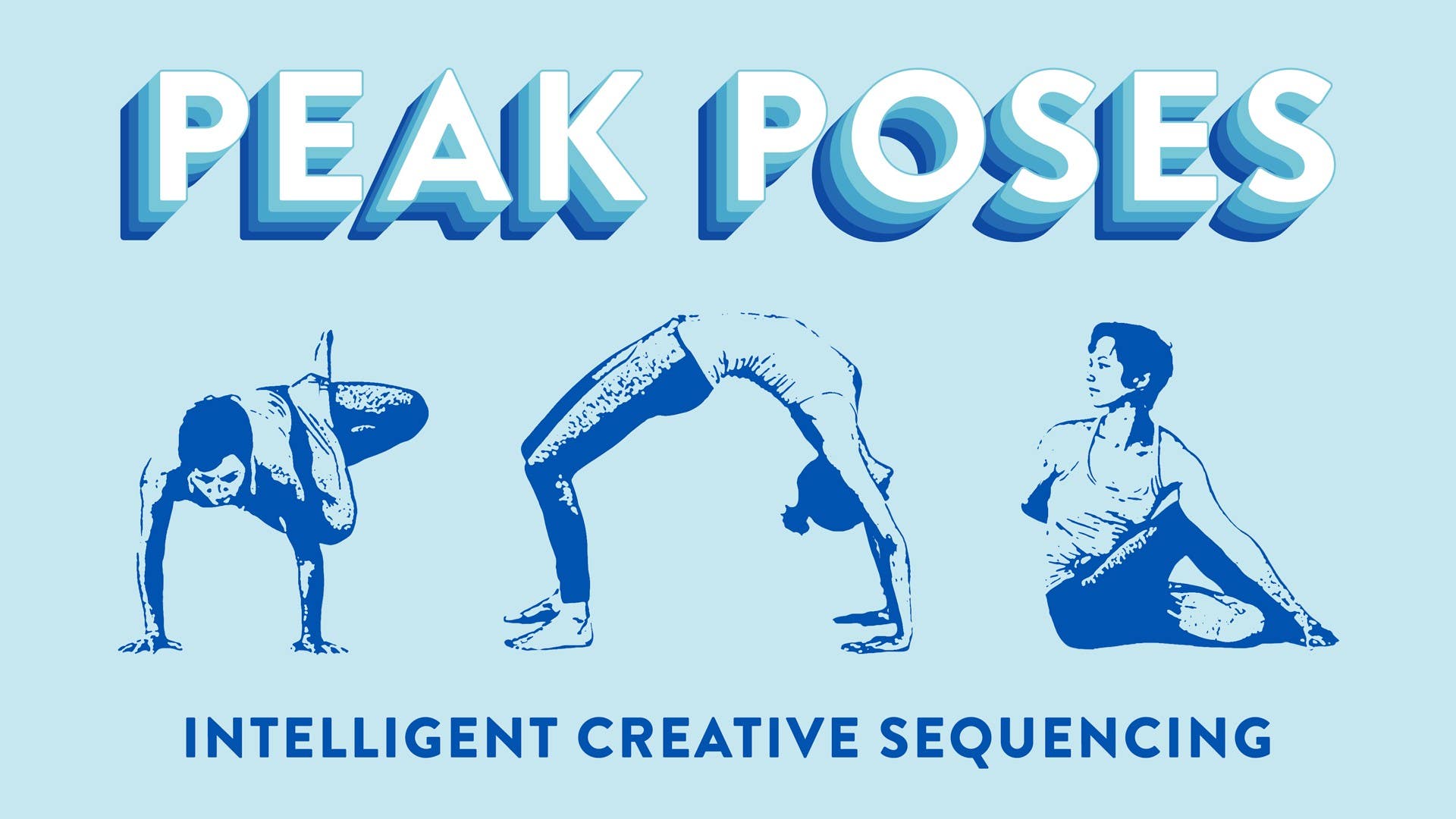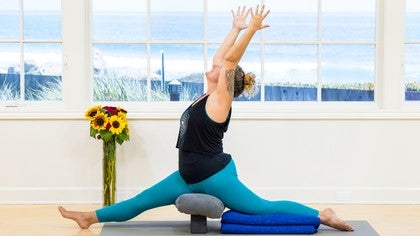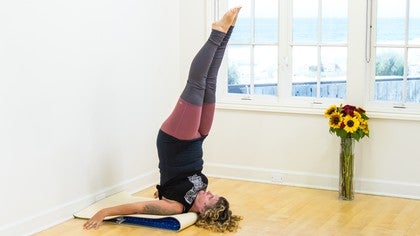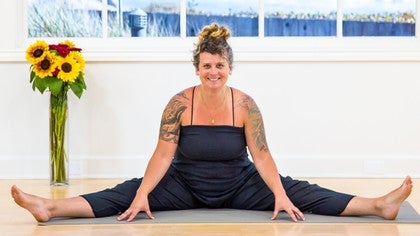Description
About This Video
Transcript
Read Full Transcript
Hi. Today we're going to work on Hanamanasana. So we're going to start with a little bit of calf and foot smashing. So I'm going to turn this way so that you can see. We'll start with the calf. You're going to take your right shin as high up onto your left calf as you can go and you really want to get the bone on the calf. And for some of us this is going to be more than enough staying here with the hands on the ground. Some people are going to be able to move yourself back a little bit and that might be enough. Some of you might be able to even shift a little bit farther. That's about where I'm going to go. I have met a sacred few who can sit all the way down. But this is a pretty intense sensation. You want to be in a place where there's intense sensation but you're not welling with tears. So finding that place. And you just kind of let the shin do its work on your calf. The top of the calf is probably the least sensitive. As we get lower it will get more insensitive. Bringing your hands back forward. Lifting the weight. Moving the shin bone a little bit farther down. And then again shifting the weight back. Doing a little rock can be nice. Staying where is within your comfort zone is good. Lifting again. This is like that under butt of the calf. Like the place where sort of your ankle turns into the calf. It is delicate there. So be mindful of that. It has a lot of sensation. The last one is right kind of at the top of the ankle. Before the heel. And you just rock back and forth. And then we switch sides. So we're breaking up the tissue. Breaking up the fascia. Getting into some big bulky muscles there. When we start to get into deeper shapes with our hamstrings.
It's nice to break up the bottoms of the feet and the calves which don't quite get as much attention as our hamstrings do. So each step you're there for just a few breaths. You lift the weight up. And then you shift a little bit lower. So I'm working my way down. And you can follow at my pace or at your own pace. Feeling free to pause or come out as needed. Looking down to that delicate part. Bottom of the calf. And ending just above the ankle. Before your leg hits the heel. You shift forward. And then we're going to do it again. This time with our knee. So you try and get and like I literally have to kind of like get myself up and over to get my knee up as high as it can go. And here I just kind of massage. I use my knee. But you can get in between. There's like a line in your calf and you can get in between there. And again, it's a highly sensitive area for most of us. So, you know, you want to be a nice massage therapist to yourself. Don't go too deep, too quick. And then we'll switch and we'll do those. And again, I kind of like how to get in this awkward position and get my knee up there because my calves are actually pretty muscular. Right? Got a lot there to work with. And then I just use my knee and I find all the tender spots.
And I work it down. And then the foot smash. So here we have similar a bone is our shin. We're running from along the big toe line up towards the ankle. We take that and it we put that right at the top part of the arch is close to the heel. And you can still do the same thing. For some of us, we're going to keep weight forward on our fingertips. Keep testing, testing, testing. For some of us, we're going to be able to sit down. And then depending on if your feet have a little bit of glide, you might be able to just do this while you're sitting. So slowly moving the foot down the arch. Right? You might need to lift forward a little bit and kind of slide it down and then sit back down and then lift forward and slide it down. I can sort of get it going once I got out of that first little spot and you run that bone on the top of your foot all the way down the arch of your left foot until you get to the ball mount. And then you switch sides. So this is like broken toe pose, but like multiplied. And so it can be quite intense and sensation. And again, you want to make sure that you're at a place where you can still breathe. You can still pay attention to the things around you. You can be in another part of your body other than just the foot. Right? Those are all ways to make sure that it's at a good place for you. Sliding my foot all the way down that arch until I get to the ball. And then I release. And then we're going to come up for a little surinamaskar for standing. I'm going to grab my blocks and put them at the front of our space. Come to your tadasana and bring the hands to the heart. Ground through the feet. Take a breath here. Full inhale. Full exhale. So really thinking about moving through this at the pace of your own breath. So if I'm speaking and moving quicker or if I'm speaking and moving slower, feeling free to continue to work with your pace. Find an inhale. Reaching the arms on up overhead. Root through your feet. Rise on up. And then exhale. Come all the way down. Find your blocks. Release the head. We'll step on back for downward facing dog. And we'll breathe here. Collecting the energy in through the side body. Down through that first knuckle. Finding a little curve.
The lower back. Inner thighs lengthening towards the floor. And take our right foot forward. Keep the back knee up here. Press back through that back heel. Ground through your big toe of the front foot. Soften your belly onto your thigh and take your gaze forward here. Find an inhale. And then exhale. Step on back. Downward facing dog. And we'll step the left foot forward. Same thing. Grounding through your big toe line of both feet. Belly softens towards the thigh and the spine elongates. Gaze goes forward. Finding an inhale here. Going back. Downward facing dog. We'll shift forward. Lower the knees down. You can move the blocks out to the side for a moment. Come all the way down onto your belly. Take the hands along the ribs. Use your feet. Inner leg line. Shoulders down and back. Broad between the shoulder blades. Press yourself up for a little mini cobra. Gaze lifts. Softening back down. Finding your blocks. Pressing yourself up and back. And then downward facing dog. Trying to walk your feet towards your hands. Come to your forward fold. Find the inhale.
Rise on up. Upward salute. Exhale. Hands to the heart. We'll do that again. A little bit different this time. Inhale. Arms come on up. Root through that inner leg line. Gaze lifts. Using your inner thighs. Exhale. All the way down center line. Releasing the head. Inhale. Extend through the spine. Exhale. Ground your hands. Step on back into your downward facing dog. Breathing here. Right leg comes forward. Virabhadrasana. One warrior. Again, ground through the back heel. Find your inner legs. So both legs rooting. Pelvis is a little bit at the diagonal. Front hip crease is soft. Pubic bone moves away. And your psoas lifting. Arms come on up. Broad the chest. Spacious here. Exhaling hands come on down. Step on back. Downward facing dog. And so Hanuman is this beautiful shape. It's a celebration of recognizing the power within us. It's a celebration of our strength and our abilities. It's a very joyous pose. So we're looking to find those qualities within the asana. Step our left foot forward. Finding the inner thighs strong. Soft hip crease. Pubic bone away. Strong side body. Gaze is lifting. And then this expansiveness through the heart. Letting this pose be a back bend. Hanumanasana is a back bend. And this is more or less the shape right here. Hands come on down. We meet our blacks. Back into downward facing dog. And then again making your way down onto your belly. I use my knees. Shift yourself down. Finding cobra again. Hands are along the side body. Use your inner leg line. Lift yourself up. Maybe a little bit higher this time. Let that pubic bone move away but use your inner thighs. Hands reaching towards the ground. Gaze lifts. Shifting back. Grabbing a hold of your blacks. And moving back into downward facing dog. And starting to walk the feet forward. Coming to your asanasana. Inhale, arch the spine. Straight legs. Exhale, face. Root to rise up. Inhale, arms come on up overhead. Exhale, hands to the heart.
Last one. Inhale, arms come on up. Exhale, we fold on down. Inhale, you extend through the spine. Exhale, your hands ground. You step on back. Downward facing dog. So here we're stepping forward for asanasana. Step our right foot forward. Lower the back knee down. Release the back toe. So this is a place where you can stay with the hands on the blocks. And even here we want to set up the base. So this back hip is allowed to open. This front hip crease is softening out to the side. If we let it just continue to go, we start to move the femur out. But we're finding our inner leg line as well. So can you do two actions at the same time? Both those actions at the same time. The softening and strength, which is hard to coordinate. There's also a strength through the back inner thigh. We let the pubic bone move away from the navel, which brings us a little bit farther forward. So again, you might just stay hands low. If you'd like, you bring your hands up to the top of the knee. Can you keep all those actions? Strong inner thighs, both legs, soft hip crease. Pubic bone moves away. And then we take our arms up. All right. Lifting the pelvis. Lifting the torso off the pelvis. Strong inner thighs. And then it starts to move back. Centering that femur of the back leg. Hands come on down. It should be a pretty big shape. Or it feels pretty big at least. Right in my body it feels like, oh my God, my hands. They're gonna touch the floor. That's the sensation that it feels. They're gonna reach so high up and over that they can move back behind me. Even though that's probably not ever gonna happen. So we step our left foot forward. We can set that up. Again, start with the hands low. Take the time to set up your foundation. Find your inner leg line of both legs, front leg and back. Soften those hip creases out to the side and then take your hands up to the top of the knee. Your pubic bone moves away from your navel. So it's like a tilting the pelvis back. There's like a booty bumping. Or like spilling the bull forward. Right? And then strong inner body lifts up to take the arms up overhead. And we keep reminding ourselves about the foundation as we go up and then back. And we go up and then back. And we go up and we go back. And then our hands come on down. Now we're facing down. And you shift yourself forward. Moving the black side of the way. That's culprit pose. Strong inner thighs. Your pubic bone is towards the floor. Arms are along the ribs. Shoulders down and back. Lifting yourself up. Right? Working towards straighter arms. Allowing that release to happen through from pubic bone away from navel.
My thigh is strong so that the back bend moves up the belly, the solar plexus, the chest, the neck. All the way out the crown of the head. And then release. Push yourself up. Raise your blocks and come into downward facing dog. Slowly stepping your feet forward. Inhale, arutanasana gaze comes forward. Exhale releasing. Grounding through your feet. Rising on up. Forward salute. Inhale and then exhale bringing your hands to your heart. Okay. So we'll set up for another anjanayasana. We're going to grab a blanket. You want to unfold it so that when you come on down, your foot is off of the blanket and the knee is on the blanket. So it's supporting your ankle. And then you'll have one block off to the side for your hand and you'll take your other block and you're going to put your front foot on it. So I'm going to set my back leg up first. And I'm going to guess to about where my foot needs to go. And I'm going to start shifting forward. So I'm using the second block of support for my other arm. And then my hand is on my left knee. So in my body, personally, I have the flexibility to move really far forward. But what I feel sensation wise is the back leg, my femur is in the front of my pelvis. And so I want to see if I can move that femur of my back leg into the center. So drawing your pelvis, it's not drawing your pelvis back necessarily. It's moving from the bones, moving from the femur, that inner thigh and realigning the back leg. And then the depth comes in from this front leg. Can you maintain both of those actions? It's really tricky. Strong inner thighs on both leg, soft hip crease. The pubic bone moves away. Arms up, serratus. Can you keep all of those actions as you start to move back? So Anjanae was Hanuman's mother. This is the pose that gives birth to Hanuman. And so it's basically the same thing, except we've got a bent knee instead of a straight leg, right in our front foot. And then we're going to switch sides. So I'll move my blanket over a little bit. Bring my block over, set the back foot up first. So the ankle supported, knees on the blanket, front foot comes to the block. And again, I'm checking in on its placement and not being afraid to come out and set it up again. So again, not moving forward. Can you find that back leg in the center, the femur in the center, the thigh bone in the center of the leg? Use your inner thigh to root. Use the inner thigh of the front leg, soft front hip crease, pubic bone moves away, then lifting up and out. Keep breathing here, reaching up, exhaling back. Don't forget about the foundations.
And releasing forward. We'll move our blanket out of the way for a moment. I'm going to come back into downward dog to neutralize my spine, reconnect and ground. So breathing here, rooting through the inner leg line, the feet, finding that slight tilt to the pelvis, strong side body, strong arms. Breathing here. And then we'll move into trikonasana. So I'm going to bring my right foot forward so we can see each other. I can move the other block out of the way. I'll have my block on the outside of my calf, my right hand on it. Back hip is tilted in, inner thighs of both legs are long and strong. So in particular, look at this is strength, this is not. Foundation. And you can feel it, like turn it on, how is the pelvis lifting up? Turn it off, notice it dumping into the bones. So we want to turn that on. And then we want to soften our hip crease. Let this sitting bone move back. Press down through the block, rotate through the spine, take the arm up. Inhale. And with your exhale, keep all of those things in side bend a little bit more. Inhale. Maybe stay here, or you might side bend a little bit more. Inhale. Maybe stay here, or you might side bend a little bit more. Gaze can be neutral, up or down. Breathing here. Take your gaze down, bend into that knee. I'm going to grab my blocks. Walk over towards the left, parallel the toes. Find an inhale here. And then exhale, fold. So here we're getting into our hamstrings in a way that's most accessible for most people. So if you're someone who is pretty open in this way and your head's already on the floor, you might take your feet closer together. If you're someone who is having a hard time to get the torso up and over the pelvis, staying here with your hands on blocks extending through the spine is a better place to be. And you might be able to take your legs a little bit wider to get some of that space. Straight legs, inner thighs, rooted and grounded, hip creases moving out to the side and then back through the glutes to take the fold. And you don't have to come very far, right? Just working where you're at. And then we'll move to our other leg for Trikonasana. So I'll take my block with me, bring it behind the foot. I set up the legs first. Find my inner thighs. So my whole pelvis lifts up and off the bones, right? Strong here, soft through my front hip crease. This sitting bone, my back leg, it's moving out to the diagonal behind me.
And if you're a hyperextender in your knee of your front leg, imagine moving the shin bone forward. Obviously, it's not really moving, but that will help you keep the hyperextension out of the knee joint, but keep a straight leg. So breathing here, this can be where you stay. Otherwise, with each exhale, you might go a little bit deeper. We inhale and then we exhale and we shift the block. Inhale and we exhale and we shift. Inhale and exhale, maybe to fingertips. Gaze comes down. I grab ahold of my blocks. Walk back around towards Prasarita. One more moment of folding here. Inhale, exhale, releasing. Maybe the hands come off the blocks and you fold the head on in. Right, if you're not there, keeping the hands on the blocks. Being okay to breathe just where you are. We come back up, walk all the way back around here. We find our downward facing dog. I'm going to come down onto my knees. I'm going to move my blocks out of the way for a moment. And I'm going to set my blankets up so that I have not only some padding underneath my body, but so that I don't get hindered by the sticky mat so that I can slide a little bit better. So the back one, I'll unfold all the way. And then the front one, I'll just unfold one time, giving myself just a little bit more height for that front hip. You've got to be a little princess in the pee-ish with your blankets. You get a little crooked in there, a little nice fold, and it can be really uncomfortable. If you're someone who can't come down in pigeon pose with your glute, then you're going to want to grab maybe your bolster or your blanket or another blanket and make sure that you have support underneath your hip. So we'll start with our right leg, right knee to right wrist. And I tuck the toes and I shift my hip back from there, right? Your shin bone is in towards your back leg. And we start upright. I want you to think about inner thigh moving away from the pelvis. And then deep within the pelvis, that's moving back through the gluteal tissues of the bent knee of the front leg. Same thing, inner thigh of the back leg moving away from the pelvis. And the back hip is allowed to sort of open, which will create more space. Operation number one here, my right knee is forward, so my right hand goes in the center. I reach my left hand back. So this is why you want to have these blankets. So what happens when we stretch through our quad is our hamstring naturally contracts. But if you pull on it, then what's happening is I am contracting my hamstring and opening or I'm contracting my quad and opening my hamstring. So what I'm wanting to do is do the opposite. So I'm soft here. I'm not pushing and I'm not pulling in any way, right? I'm relaxed as best as I can. And then I'm using my like psychic yogi powers of superness to like move from my pelvis of that inner thigh line so that maybe it starts to shift back and I get a deeper stretch in my quad. Not because I'm pulling on something, but because I'm moving from inside my body. And it may not look like much, right? I can press my heel to my butt, but this is a different teaching our body a different way of doing this. And then we lift, we release that, we come out. I'm going to swing around neutral and then swing back around. And I get the other side. So I shift the hips back. My front knee is at a diagonal. I check in here, breathing, finding all those components, moving out, moving out, soft hip creases. And then since my left leg is for my left arm is in the center, right hand reaches back. Notice the tendency to engage in either way, right? Some of us do it differently, right? We always push back. We always pull in and just notice if you can't reach your foot, you might grab a strap. It's a great way to do this too. And then you're using again, your inner sense, your felt sense of your body, and you're moving out along that inner thigh. And what happens like when you can get it, it starts, the knee joint starts to close. And it's not as big as you might do if you were pulling on it, but it's teaching your body something and it's pretty awesome. We release, swing around, legs extend, come back. This time, so my right knee is forward. I'm going to put my left hand in the center. I'm going to reach my right hand back and I'm going to try and do the same thing here. Move from my inner thigh. And here I want to go a little bit lower as that quad starts to release. And again, I'm not pulling. I'm really moving my inner thigh long. It's a very different stretch sensation than when I pull. When I release, swing around. Dandasana neutral. Other side. So left foot is forward. So right hand through the center, left foot back. Notice how my thumb is down for all of these. I'm not, I'm doing internal rotation with my arm. My thumb is down. Right?
So again, inner thigh working to stretch the quad. The hamstring naturally contracts. And it helps me to move a little bit deeper. You might come on down. You might be even flat on the ground. And then we release. Bring the legs forward one more time. Sitting up. And then I'll move my props out of the way one more time to come back into our downward facing dog. And grab onto my blocks. So they're there. I'm using my downward dog here. It's a place to reintegrate everything. And take a note, right? It's always nice to really notice how does my downward dog feel that very first one? How does it feel after I've done some standing work? How does it feel after I've done some hip opening? Or back bends? Start to play with this in your regular practice. Start to notice the differences. What helps you feel more nourished in this pose? Do you need opening in the shoulders or the hamstrings? And taking notes about yourself in that way. We'll step our right foot forward for Parsvottanasana. So even if you can bring your hands all the way to the ground, let's all bring our hands onto blocks on the highest setting. Find that inner leg line on both feet. And then soft front hip crease. And then I'm going to push into the blocks. And I'm going to extend my spine out. And it's as if I want to pull the blocks back behind me. But I'm not actually going to do that. I'm just going to pull through. But they're not going to move. So I'm pushing down and pulling back and extending out through my spine, taking the gaze farther along. Big toe ball mounted. That front foot is really working. And then I come up and over the front femur. Strong straight legs as best as we can. Here, maybe the hands start to release back. Keep breathing. And then we'll take our blocks with us as we shift forward here. Getting light on that back leg until it comes up. Right. And starting to move towards the standing split. So I'm rooting down through that front foot. And I'm allowing some external rotation here. I take one hand to the foot to start. And I might find the other one on the floor. And then I release on back through the long lunge. Ground my blocks. And step back downward facing dog. And the left leg comes forward to the other side. Rooting through the inner leg line on both legs really strongly. Softening that front hip crease. Pressing down through the blocks. And dragging. Right.
That dragging sensation to elongate the spine. Again, if you're a hyperextender, moving that shin bone forward to keep out of the hyperextension. Right. But if you're a microbender, can you find straight legs? Notice what it feels like to open up the back of the knee joint. That's good for your knees. And then once we get in this up and over, then you're folding. Right. My left leg is my less flexible leg. Right. And so noticing that, which leg do I need to work on? My least favorite leg. Right. Don't deny those sides of us. And folding here. And then we're moving forward again for the standing splits. I bring my blocks with me for a little bit of extra support. I get light on that back leg. And then I start to move forward. Right. I might take one hand to the ankle. And fold in. Send it nice and long back behind you. Bring your blocks with you. Downward facing dog. Shifting forward. I'm going to talk about upward facing dog before we move into our Hanuman. So in upward facing dog, a lot of times we want to use our glutes a lot and push our pubic bone forward. And what I'm going to ask you to do is to learn how to use your inner thighs and let the pubic bone go back. So this is pushing it forward and we want to move it back. And it takes some coordination. But when you think about it, once it all happens, it's like this channel of chi or channel of Prada or like the energy of the pose is free to move up. And there's no kinks in it. And it's this glorious in our community. We call it moist eyeballs. It's from Todd Jackson, one of my teachers, like moist eyeballs, backbends.
Oh, right. You're like, I want that. Right. I don't want the one with the kinked hose. I want the water to get all the way to the top. So your hands are way farther back than you think. And I'm using blocks so that I have the space to find the backbend. I press myself up. Right. So this is pubic bone forward. Right. And I want to release it back through my inner thighs. And I can already tell you to go farther forward. Right. Inner thighs working pubic bone released and then boom, shlaka, shlaka. Right. All the way up. It's working pubic bone away from navel. Grown up. Backbend. And release on out. So that's harder than. Right. But it's the same actions. We'll start with the prep variation. And this is where you can totally stay. So you'll have your two blocks. You'll take your right leg forward. You'll straighten it out. Right. Your hip is over your knee. If your knees are sensitive, grab a blanket, place it underneath here. I like to have the toes pointed. Right. It might be this. You might need multiple blocks. So you get another set and put it on the other side. Right. For some of us, we're folding forward here and releasing. Some of us are bringing our hands to the ground and folding a little bit further. Staying where you can stay in your body. And the whole thing, not just one part. Right. When we're hyper focused on one part, it usually kind of means that that part is overextending. So we want to find balance here. We do the other side. Check in. How is it different?
What's the same? What do I need to do? So I'm having the point foot because if I flex it, I'm tightening all the entire, I'm taking up all the slack of my fascial line. So I'm allowing there to be some slack so that I can get into my hamstrings more easily. Grounding here. And then releasing. Maybe hands come down. Maybe they don't. And the head starts to release. Bringing the hands up onto the blocks. Bring back down on your knees. So here we're going to set up for our Hanumanasana. I believe everyone can do it. And if you are someone who can normally put your seat all the way down on the ground on your Hanuman, I want to invite you to still use the propping just because we're doing moist eyeballs Hanumanasana and not just I want to get into the pose. So get my butt on the floor Hanumanasana. So we'll take two blocks. We'll take a bolster. And two blankets. Again, making sure that you. Right? That's pretty high. We're going to start here and we might do it a second time with less. But this is I like to start with more than I could possibly need so that I can learn that tilt of the pelvis and the release of the chi up because that's what I want. Not just my hamstrings. There's lots of ways to stretch your hamstrings. And I don't know Hanumanasana is a pretty intense way to do it. So we can focus on something else besides our hamstrings. So I'm going to start in the lunge. You want to make sure that the center of your pelvis is on the propping so that the prop is taking your weight. Right? And this could be where you could stay, right? Anjaliasana, mother pose, right? Creating this joy. Hanuman in this pose represents the moment that he leapt over the ocean. It's the moment that he like remembered that he was God. And so what does that feel like to know your truest nature? What does that feel like to express that? It's certainly not like crying on the floor because I'm stretching my hamstrings so much, right? So I'm like I'm taking the hamstrings out of the equation. I'm finding my inner thighs and my back leg lifts up, right? And then here pubic bone moves away. So I'm tilting forward, strong inner thighs like hello world. And then my arms reach up and the chi is like, hello, hello, hello, all the way up and then back and up and back and up and back. And it's glorious, right? So yummy. And there's also a hundred other ways to prop this, right? I can have a little bit less here and more propping underneath my knee. And I really want to invite you to be a scientist and to like, be like, I want this here. I'm going to shove this here. So this is just kind of set up number one and then moving from here to find the one where, wait, I think I feel what Hanuman felt, right? I can see why this pose is named after him, right? Not just because of the physical shape, but because of the sensations that I can get in my body when I'm engaging, right? My back hips allowed to open. I'm reaching through my inner thighs. It's like, oh, and then like my pubic bone moves away to take everything up and off. So I can lift up and back and up and back and up and back, up and back. It really is so sweet. Okay. And then we come on out and we want to put our bones back into their home. So slowly take your time to come off your setup. We'll move some of our props out of the way here. And I'm going to take one black put it onto my heels, draw my thighs in, root through my sitting bones, bring the hands to the heart, find a full inhale and an exhale. Taking one more inhale here, exhale here. Taking the seat up off the block, taking your other one, you're going to put your left foot on the floor, one block underneath that hip and be sitting on your right. And then take the other block behind you. So the idea here is not to, again, to get into like the deepest twists that you've ever done in ever in your life, but to start to reintegrate everything.
So we're going to take our right hand to the knee. If it's really natural and easy for you to bring the hook, notice how if I have to hook, I have to lean forward. So I'm going to, if you're doing that and you're leaning forward, I suggest that you have your hand. If your arm leg situation ratios are long enough so that you can do this without leaning forward, great. Otherwise hand on the knee, pressing down through the block with the floor behind you. And then I'm taking from within my hip all the way along this line out to take the twist from my navel. Just kind of like that crocodile twist, removing a long lower kidney out through the knee and then twisting with the navel. And then we release and we switch sides. So our right knee is down or our left knee is down, sorry, and our right foot's on the floor. I have a block underneath my seat for support and the hand, the block behind me for my arm length. My left hand comes to the knee. I'm consciously moving this line, so around and through here. And from that place, that's where the twist comes in. It's a very different sensation than just gripping onto something and twisting. We're creating space in the back of our pelvis. And it should feel pretty nice. I'm releasing this. I'm putting the blocks off to the side. So we're going to take a supported Navasana. You're going to want to loop up your strap. And you need kind of a long strap for this. You can also do it unsupported, right? But supported is kind of fun. Let's see, I'm taking a guesstimate about how long my legs are. I put it over my head and underneath my armpits and it's across my shoulder blades. That's about right. And then I balance on my feet. And then I press my feet in to the strap and I draw the femurs into their socket.
And so there is definitely core, but it's not like regular Navasana. It's a great reintegration of your femurs into their homey sockets of your pelvis. And it sort of feels like somewhere I could like take a nap. Not really, but a little bit. Be careful because sometimes you can fly backwards and come on out. You can always pause it and stay there and play with that a little bit more if it's the first time venturing into that kind of support. Here. And then we're going to flip around. Come on down for constructive rest pose. Last reintegration. All right. Feet are a little bit wide. Knees are together. I'm allowing a little bit of that natural curve on my lower back. And I'm drawing femurs in. So consciously moving them in. You can press the knees together a little bit. And that can help as well. And then we'll slowly start to extend our legs out for Shavasana. Again, this is always a place for pausing. The video, if you want to take a nice long Shavasana, grabbing your props, setting yourself up so you're nice and snugly. You can stay as long as you'd like to. Otherwise I'll talk us through just a little bit of relaxation a few moments here. I'm taking note of the floor underneath us. You widen through the backside of the heart. What does it feel like to allow that part of our body to really soften into the ground? Let the weight, the lungs, the ribs, the heart moving to the space towards the floor. Letting the lips part, the forehead soften. And can you notice that whole channel from the crown of the head through to the feet and from the feet up the center all the way out through the crown. Releasing the heart to the floor. Staying here for as long as you'd like. Otherwise bending into the knees. Coming on over to your side body and pausing here, just taking a rest, reintegrating yourself, becoming yourself back home, into your life, into the space around you, into your relationships.
When you're ready, you're pressing yourself on up to a seat. And the hands to the heart, pull the head on in. And blessing in finding our truest nature. Namaste.
Peak Poses: Jessica Garay
Comments
You need to be a subscriber to post a comment.
Please Log In or Create an Account to start your free trial.



















